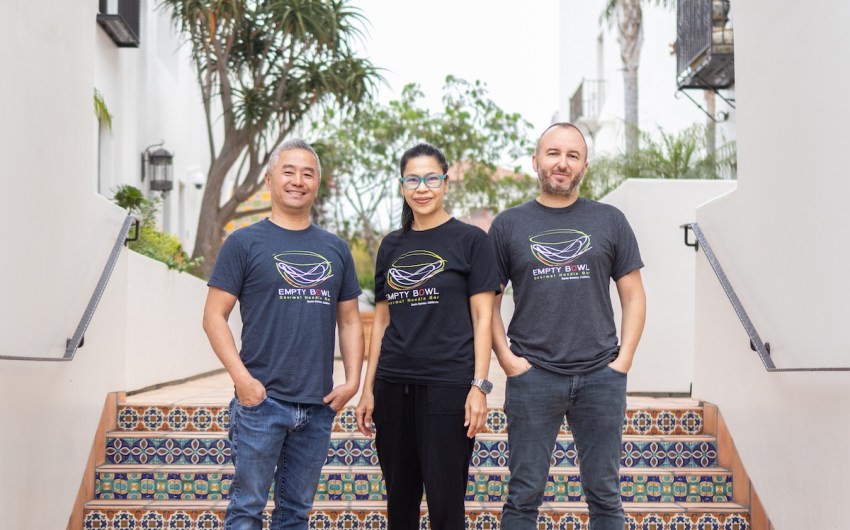This article was originally published in UCSB’s ‘The Current‘.
There are over 2,000 different types of edible insects, and each one has a different flavor profile. There can be subtleties too, such as, if you feed them mint, they’ll take on a minty flavor, or some just taste more meaty and fatty like bacon, while others hit a bit lighter, in a way comparable to shellfish.
“‘What does an edible insect taste like?’ That’s like saying, ‘What does meat taste like?’ But the taste of chicken compared to lamb is very, very different,” said Mackenzie Wade, a doctoral candidate in anthropology and co-founder of UCSB’s Edible Insect Initiative (EII). “Chefs are showing the culinary diversity of insects.”
Wade and EII co-founder Alex Carlin, an environmental studies major, have organized the Edible Insect Art Show (April 1–5) to be held in the GlassBox Gallery, featuring artwork related to insects as food, a discussion panel and tasting opportunities.
The multimedia exhibition aims to bring the community together to celebrate insects as a component of cultural cuisines and raise awareness about their potential as a climate solution. A culminating panel, featuring documentary photographer and filmmaker Umberto Diecinove and edible insect experts and cultivators Aly Moore of Bugible and Monica Martinez of Don Bugito, will be held on April 4, 5–7:30 p.m. Insect dishes will be provided by La Calenda SB.
Diecinove will discuss his film I N S C T S which depicts his yearlong sojourn around the world documenting people who farm, consume and research insects. “He has this deep global perspective and this very artistic story that he’s telling through his photos,” said Wade, who met Diecinove at the annual insect eating conference, Insects to Feed the World.
Martinez, who is based in California, and is the founder of Don Bugito, will be speaking about what it’s like to farm crickets and mealworms along with the influence of her Latinx background and connection to Mexican cuisines.
Through this conversation Carlin noted a hope to “exemplify admiration and appreciation for how insects play a vital role in our ecosystems, as key species, and to present how insects have served this purpose for communities all around the world.” She added: “The exhibit is curated with insect-admiration at its forefront.”

Featured art includes printed clothing and photography by environmental studies student Camille Zimmer; sculpture by ecology doctoral candidate Siena McKim; video art by Director of the Cheadle Center for Biodiversity and Ecological Restoration Katja Seltmann; and painting by art alumni Alyssa Gikkas.
The EII is an interdisciplinary project developed by Carlin in the Environmental Leadership Incubator, which is led by Simone Pulver. After an experience eating chapulines (grasshoppers) with her family in Mexico, she was inspired to bring awareness to potential climate solutions and make visible what is often overlooked in this sector.
Intrigued by human perception of insects as food, Wade’s doctoral research focuses on the people in the U.S. who are trying to change perceptions of insects as a potential food source. Working with CEOs of insect companies, chefs and educators, she studies how people promote the idea of insects as a sustainable and ethical food option.

“As an anthropologist, I research the deeper, historical reasons for why we often have this aversion to insect eating in the U.S. and what it would take for a big cultural shift to a food source that is potentially more sustainable, but also potentially more ethical in the food system,” Wade said.
Her research has shown different approaches to educating and marketing to consumers. “A popular example of an edible insect is Acheta, which is just a cricket, but they use the scientific name, so it’s not as apparent that you’re eating bugs,” she said. “Some companies take the opposite approach and really lean into it. They’ll call them ‘hopper snacks’ or something like that and will show crickets all over the package. There are different approaches to normalizing insect consumption but a lot of advocates try to create products that are more familiar to American consumers such as protein bars and tortilla chips that include ground insect flour.”
One such company is Entomo Farms, one of the longest running cricket farms that produces for human consumption in North America. Their crickets come in different spiced varieties and will also be given out at the tasting event.

“In Santa Barbara County, we have a large Oaxacan diaspora community and Oaxaca is one of the areas where insects are an important part of the cultural cuisine,” Wade added. Carlin also noted the importance of including the perspective of “Oaxacalifornia,” highlighting how Oaxacan cuisine has been brought to California through this diaspora.
“This space has allowed for the creation of places of diversity, resurgence and solidarity in the presence of the oppressive forces of globalization,” Carlin said, noting the exhibition will also feature documentation of the Los Angeles restaurant Chiguacle Sabor Ancestral and its owner Alonso Arrellano, who offers cuisine from Southern parts of Mexico such as Puebla and Oaxaca.
By collaborating across disciplines, Carlin and Wade hope to dissolve negative preconceptions of the role of insects in nutrition, explore the potential of insects in addressing climate change in the agricultural sector and promote healing and community. The project is sponsored by the Interdisciplinary Humanities Center, Undergraduate Research & Creative Activities, the Graduate Student Association, and The Green Initiative Fund.



